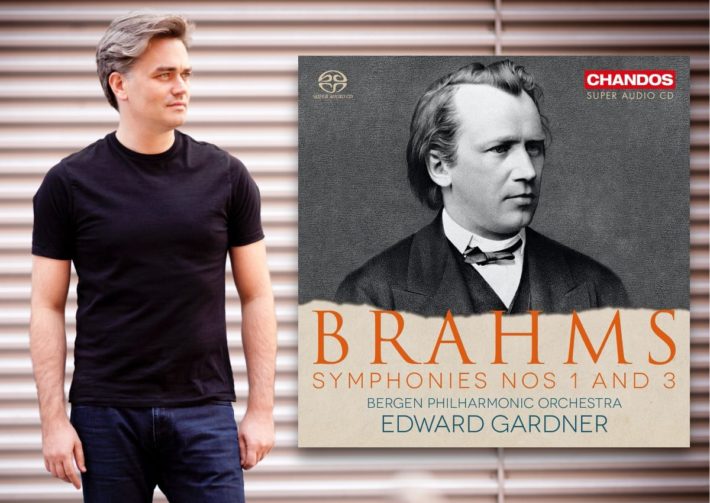Image: ©️ Benjamin Ealovega
Norway’s Bergen Philharmonic Orchestra has made a name for itself with its distinguished history (Edvard Grieg was Artistic Director from 1880-1882) and diverse repertoire ranging from Tchaikovsky to Halvorsen. Under the leadership of Edward Gardner, it takes on an ambitious project with its new cycle of Brahms Symphonies.
Overall, Gardner’s interpretation of the First and Third Symphonies is orchestrally well-balanced, stylistically cohesive, and musically polished. However, there is a noticeable lack of dynamism and vibrancy found on other recordings such Karajan with the Berlin Philharmonic in the 1970s or earlier still, with Toscanini and the NBC Symphony Orchestra, on their celebrated cycle from the early 1950s.
Symphony No. 1 demonstrates Brahms’ use of colorful harmonic language, rich orchestral texture, and meticulous phrasing. Unfortunately, Gardner does not emphasize the latter two elements, which are crucial throughout the work. In the slow introduction of the first movement, the timpani’s pedal point should be likened to a powerful heartbeat. Gardner’s opening at eighth note = 88 can’t really count for “un poco sostenuto”. The timpani lacks a singular presence and is treated more as metronomic accompaniment. This becomes obvious when compared to Karajan’s recording: not only does Karajan take a slower tempo, but the timpani holds a weight almost equal to the rest of the orchestra, making the opening far more arresting. Gardner does display moments of delicate musicality, such as the expressive interchange between oboe, flute, and cello shortly before the Allegro section. However, the entire movement is missing in gravitas, as the conductor takes to extremes the staccato markings in the score. This is evident in the first violins in the Allegro: notes and phrases are so short that they seem purposefully clipped. While this at times gives the movement a burst of buoyant energy, it is not consistent with Brahms’ sweeping melodic lines and dense textures.
Symphony No. 3 suffers from similar issues, particularly apparent in the famous third movement Scherzo. Here, Gardner takes eighth note = 93, giving it a waltz-like quality, further supported by elegant contrabass pizzicatos. However, the melody is given an awkward forward push as the breaths between phrases are cut short. When presented in the cellos and violins, it lacks salience and proper phrase shape, sounding instead limpid and nonchalant. That it is also too-well integrated into the complex accompaniment, and does not allow the listener to fully appreciate its beauty. For example, the dialogue a sixth apart between the violins and cellos (0’48”-0’56”) is ultimately lost. These lines stand out much more in the Karajan and Toscanini recordings, which both take a slower tempo (the latter almost dirge-like) and capture the movement’s tragic yet elegant quality. In Gardner’s recording, the French horn and oboe interchange in the recapitulation lacks the multidimensionality and contemplativeness that Toscanini’s interpretation in particular possesses.
Gardner’s fourth movement maintains the buoyancy of the Scherzo. This, however, seems at stylistic odds with Brahms’ harmonic construction of the singular melodic line as an undulating, chromatic dominant pedal point in the indicated key of F minor. Where there should be a sense of tension and foreboding, Gardner and his brisk tempo fail to capture these important qualities. The tempo taken by Gardner is the ultimate downfall of this movement. The listener ends up not just feeling rushed but also unable to recognize the intensity of what Brahms wrote, even at the long-anticipated arrival of F major at the end.
The album was recorded at the Bergen Philharmonic’s home base of Grieghallen, a 1500-seat concert hall. Using Surround Sound technology, it is meant to let the listener feel engulfed in the music, but the unfortunate result is a feeling of sitting far away from the orchestra. Any raw edges (the blaring of the brass or sweeping of the strings) that are so essential in capturing the dramatic ethos of these symphonies are overly evened out. While the well-roundedness of the recording is welcoming at first, it quickly gives way to a diluted sensation that eventually causes the listener to lose focus in the listening experience.

Brahms – Symphonies No. 1 and 3
Bergen Philharmonic Orchestra
Edward Gardner – Conductor
Chandos, hybrid SACD CHSA 5236
Brahms Symphonies – Comparisons
Follow Us and Comment:
Get our periodic classical music newsletter with our recent reviews, news and beginners guides.
We respect your privacy.









